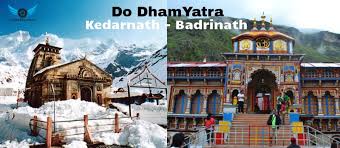|
Kedarnath Badrinath Do Dham Tour Package Itinerary
Day 01: Haridwar – Guptkashi (220kms/8-9hr) Height: 1319 MTS.
Meet our driver at Haridwar morning and drive to Guptkashi via Rudraprayag & Devprayag. Enroute you can see the beautiful river Ganga and Alaknanda River till Rudraprayag. The Mandakini river comes from Kedarnath, drive alongside the river to reach Guptakashi, visit Ardh Narishwar (Vishwanath)Temple in Guptakashi. Check into the hotel arrival in Guptakashi. Overnight stay at Guptakashi.
Guptakashi:- The name Gupt Kashi means “Hidden Benares. Mythology describes how when the Pandava brothers were searching for a glimpse of Shiva, Shivji first concealed himself at Guptkashi, but later fled from them further up the valley to Kedarnath, where the Pandavas finally got their wish fulfilled. There are more tangible connections as well-the Kedarnath pandas (priests) live in Guptkashi during the winter months, and after the Kedarnath temple closes for the winter, the image of Kedarnath passes through Gupt Kashi on its way to Ukhimath (across the valley), where it stays for the winter.
Guptkashi Weather – pleasant in summer, the temperature ranges from 25-30 degree Celsius. Cold in winters.
Day 02: Guptkashi – Kedarnath – Guptkashi (30kms by road & 19kms Trek one way) Height: 3384 MTS.
By Helicopter: Morning our driver will transfer you to your prebooked Helipad. After Back our car will drop you at Hotel for rest. (note: helicopter ticket is not included in this package)
By Trek: Though it is difficult to go up and down from Sonprayag on the same day by trek. But it can be done if you take ponies or helicopter while going to Kedarnath. Do coordinate well with driver, as due to parking issue driver cannot stay at Sonprayag also network issue is also there.
Kedarnath: The Kedarnath shrine, one of the 12 jyotirlingas of Lord Shiva, is a scenic spot situated, against the backdrop of the majestic Kedarnath range. Kedar is another name of Lord Shiva. According to legend, the Pandavas after having won over the Kaurava in the Kurukshetra war, felt guilty of having killed their own brothers and sought the blessings of Lord Shiva for redemption. He eluded them repeatedly and while fleeing took refuge at Kedarnath in the form of a bull. On being followed he dived into the ground, leaving his hump on the surface. The remaining portions of Lord Shiva appeared at four other places and are worshipped there as his manifestations. The arms appeared at Tungnath, the face at Rudranath, the belly at Madhmaheshwar and his locks (hair) with head at Kalpeshwar. Kedarnath and the four above-mentioned shrines are treated as Panch Kedar.
Kedarnath Weather – Due to its high altitude the weather in Kedarnath remains cold for most part of the year. Summer here is cool and pleasant while winter is severe. During summer season the temperature varies around 20°Celsius. Light woolen wear is recommended. Winter season in Kedarnath is severe with mercury falling to as low as 0°Celsius. During this time the place experiences snowfall as well. Due to the extreme climatic conditions, this time is usually avoided by tourists.
Day 03: Guptkashi – Badrinath (160kms/7hr) Height: 3133 MTS.
Morning after breakfast, drive to Badrinath. Check in to the hotel arrival in Badrinath. Pilgrims after having a bath in the Taptkund have the Darshan of Badrivishal & Aarti in evening. Brahamakapal is significant for Pinddan Shraddh of ancestors (Pitrus). There are other interesting sightseeing spot like Mana, Vyas Gufa, Maatamoorti, Charanpaduka, Bhimkund and the “Mukh” of the Saraswati River. Just within the three kms of Badrinathjee. Overnight stay at Badrinath.
Badrinath one of the ‘Ancient Four Dhams’ is one of the most celebrated pilgrimage spots of the country and is situated at an elevation of 3, 133 meters, guarded on either side by the two mountain ranges known as Nar & Narayan with the towering Neelkanth Peak providing a splendid backdrop. This revered spot was once carpeted with wild berries. Thus the place got the name “Badri van”, meaning “forest of berries”.
Tapt Kund : Natural thermal springs on the bank of the river Alaknanda, where it is customary to bath before entering the Badrinath temple.
Mana Village : Inhabited by an Indo-Mongolian tribe, it is the last Indian village before Tibet.
Vasundhara : As the name suggests, vasundhara is a magnificent water fall. This place is 5 kms. from Badrinath out of which 2 kms. is motorable upto Mana.
Badrinath Weather: The average maximum temperature will be around 18° Celsius and the average minimum is 8° Celsius. Warm and woolen clothes are hence required for a stay in Badrinath throughout the year. Winter in Badrinath is often accompanied by snow falls. Winter is very chilly with an average
|



